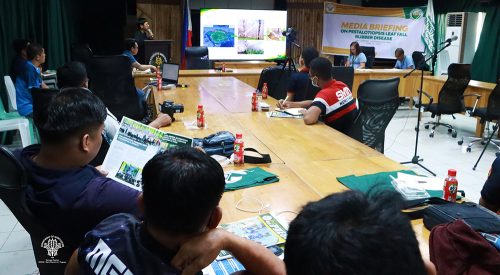 |
To widen awareness of the emerging disease of rubber named Leaf Fall Disease, DA-Caraga conducted a media briefing held at the DA Regional Office on June 13, 2023.6.14
Emmylou Presilda, Chief of the Regional Agriculture and Fisheries Information Section (RAFIS) emphasized the importance of the media to grasp the basic knowledge on the said disease to help disseminate the information effectively.
“We’ve been employing various strategies in our info dissemination, and we see to it that you (media) will also be capacitated since you are a great help to level-up the awareness of the public through your respective media platforms,” she stressed.
Charles Castro, Science Research Specialist II of the Research Division explained that Leaf Fall Disease is a fungal disease caused by a pathogen called Pestalotiopsis sp. and is considered a grave threat with the reported outbreak in Asian rubber-producing countries such as Malaysia, Sri Lanka, Thailand, and Indonesia, and even in Cameroon in Africa.
“This rubber disease if left unchecked may cause leaf defoliation or falling of leaves of about 80-100% and may result in reduced productivity in the worst affected areas of about 70-90%, and 30-50% for moderately affected areas,” he explained.
The infection will affect all rubber plant stages and its parts such as immature trees, leaves, and even seeds. On the leaves, the infections show circular light to brown spots with a clear boundary between the healthy and infected; and coalesce into an irregular spot.
Based on data gathered from extensive monitoring, all rubber plant clones are susceptible to the new disease. But if detected in its earlier stage, and proper management had been employed, affected trees can recuperate from the damage.
“A severely affected rubber tree may result in mortality of the tree, hence early detection and proper management is crucial,” Castro stressed.
Based on Food and Agriculture Organization Corporate Statistical Database (FAOSTAT), as of 2021, the Philippines ranks 8th among countries producing rubber.
In the Philippines, according to 2022 Philippine Statistics Data (PSA), Caraga is 4th among top producing regions with a production of more than 17.4 metric tons (MT) with Zambonga Peninsula on the top spot, followed by SOCCKSARGEN and third is BARMM.
As of 2022 PSA data, the country has 240,000 hectares total area planted with rubber wherein Caraga Region contributed 6% equivalent to 13,176 hectares.
Agusan del Sur is the main rubber producer in the region which accounts for about 93.32% or 16,316.96MT out of the 17,484.74 MT of cup lumps in 2022 across all municipalities.
“DA-Caraga supports the industry through provisions of planting materials, production facilities, training, post-harvest and processing facility, techno-demo and irrigation,” Dailinda Mamalis, High-Value Crops Development Program Regional Coordinator said.
Mamalis added that DA-Caraga will work with the Philippine Rubber Research Institute (PRRI) to strengthen the collaboration with the local government units in protecting the rubber industry in the region.
PRRI is a newly created institute under the Department of Agriculture as one of its attached agencies. It is mandated to initiate and administer research and development (R&D) programs to improve quality and increase rubber productivity, especially for the benefit of smallholder rubber producers and processors with its interim office based in Zambonga Sibugay.
Moreover, Regional Technical Director for Research, Regulations, and Integrated Laboratories Abel F. Wagas urged the rubber growers to help boost the immunity of their crops to withstand diseases.
“Just like our body, rubber or any other plant need to have a strong immunity against diseases through proper cultural management such as fertilizer application, maintaining cleanliness, and bio-security measures,” he said.
Aside from the media briefing, DA-Caraga through RAFIS also conducts an information caravan to the farmers in rubber-producing municipalities in the region to raise awareness and partners from the local government units. The info campaign was also boosted through broadcast, print, and social media platforms. (Aurelius Parido Arais/DA-Caraga)






